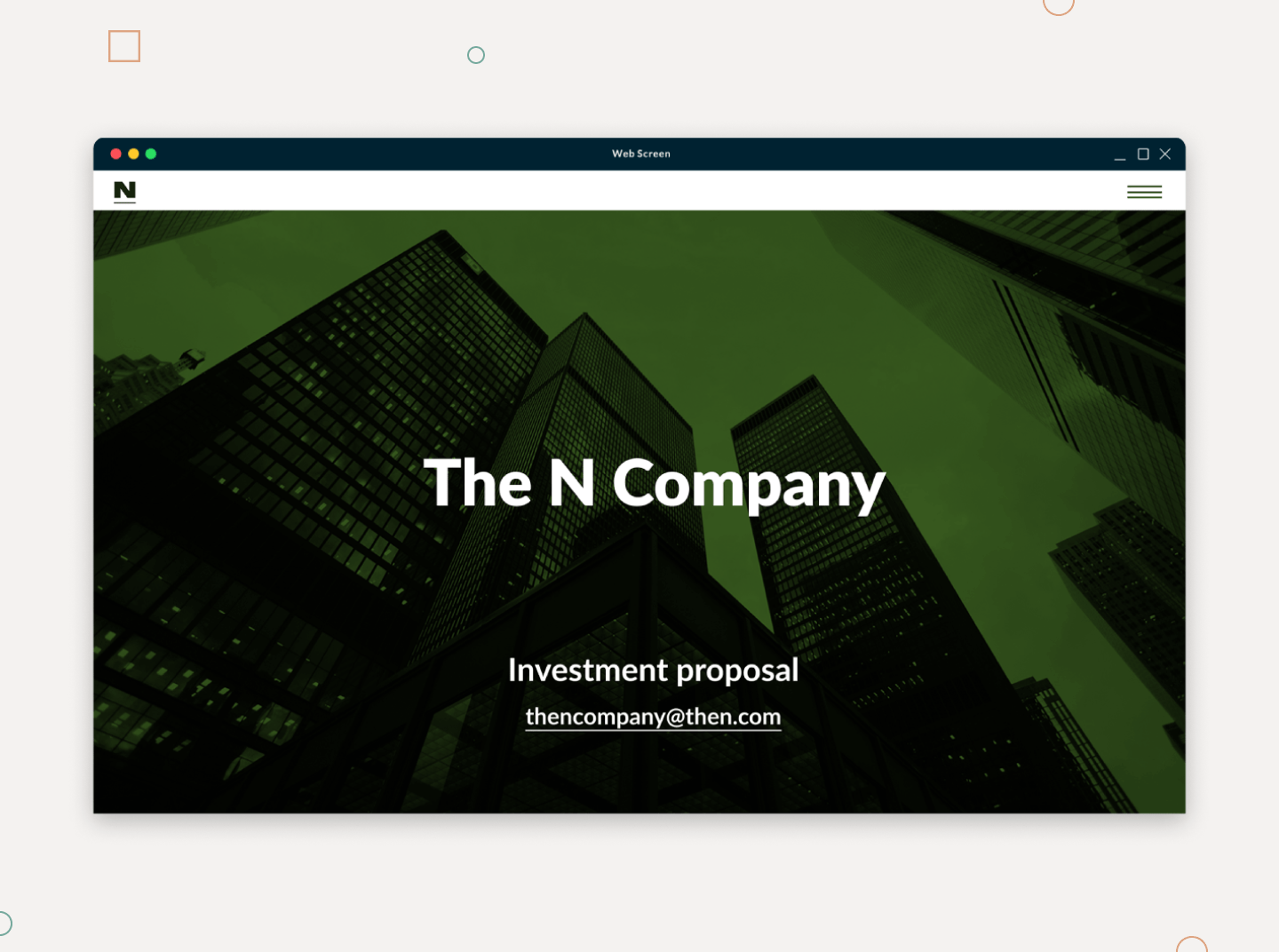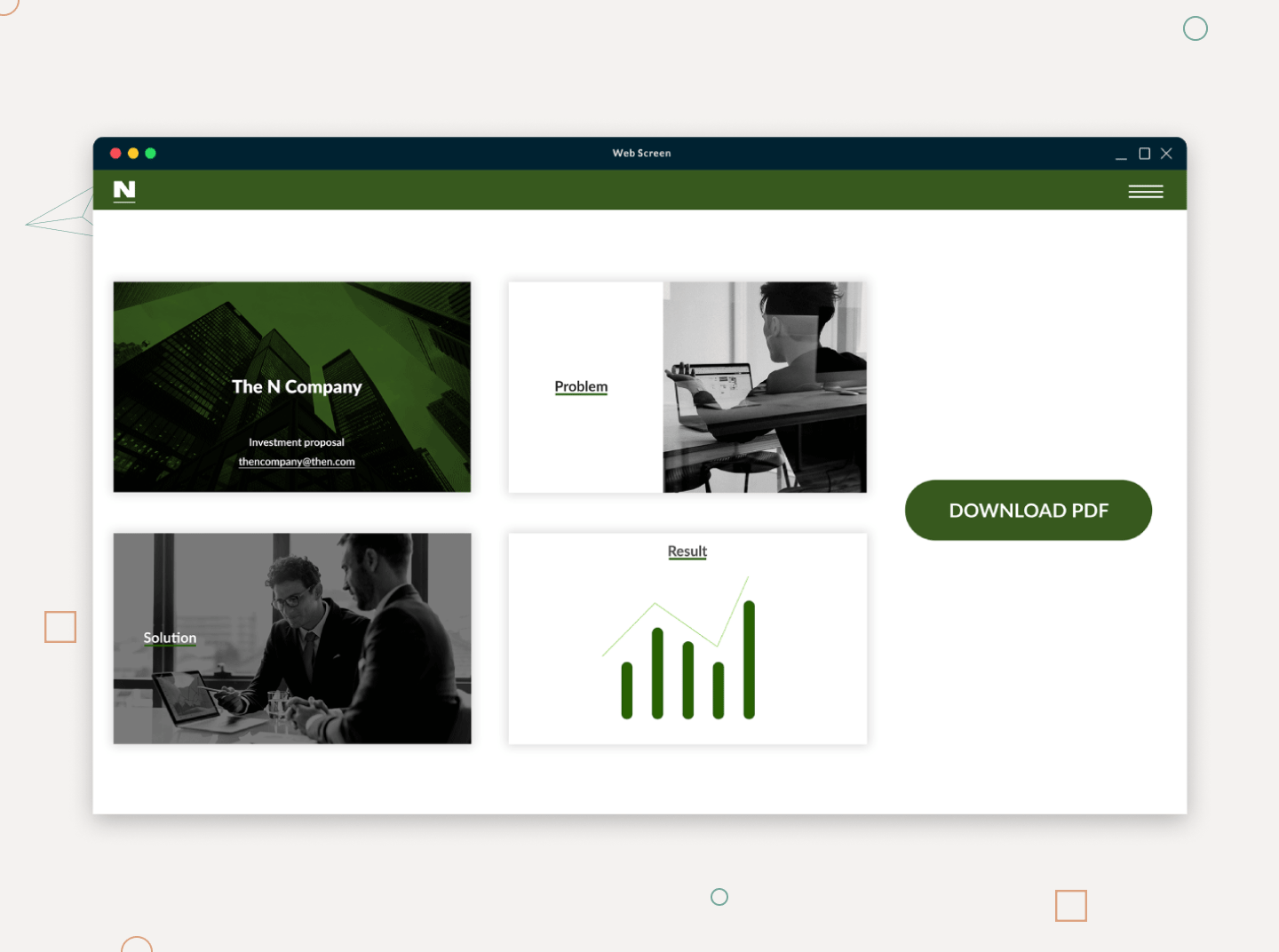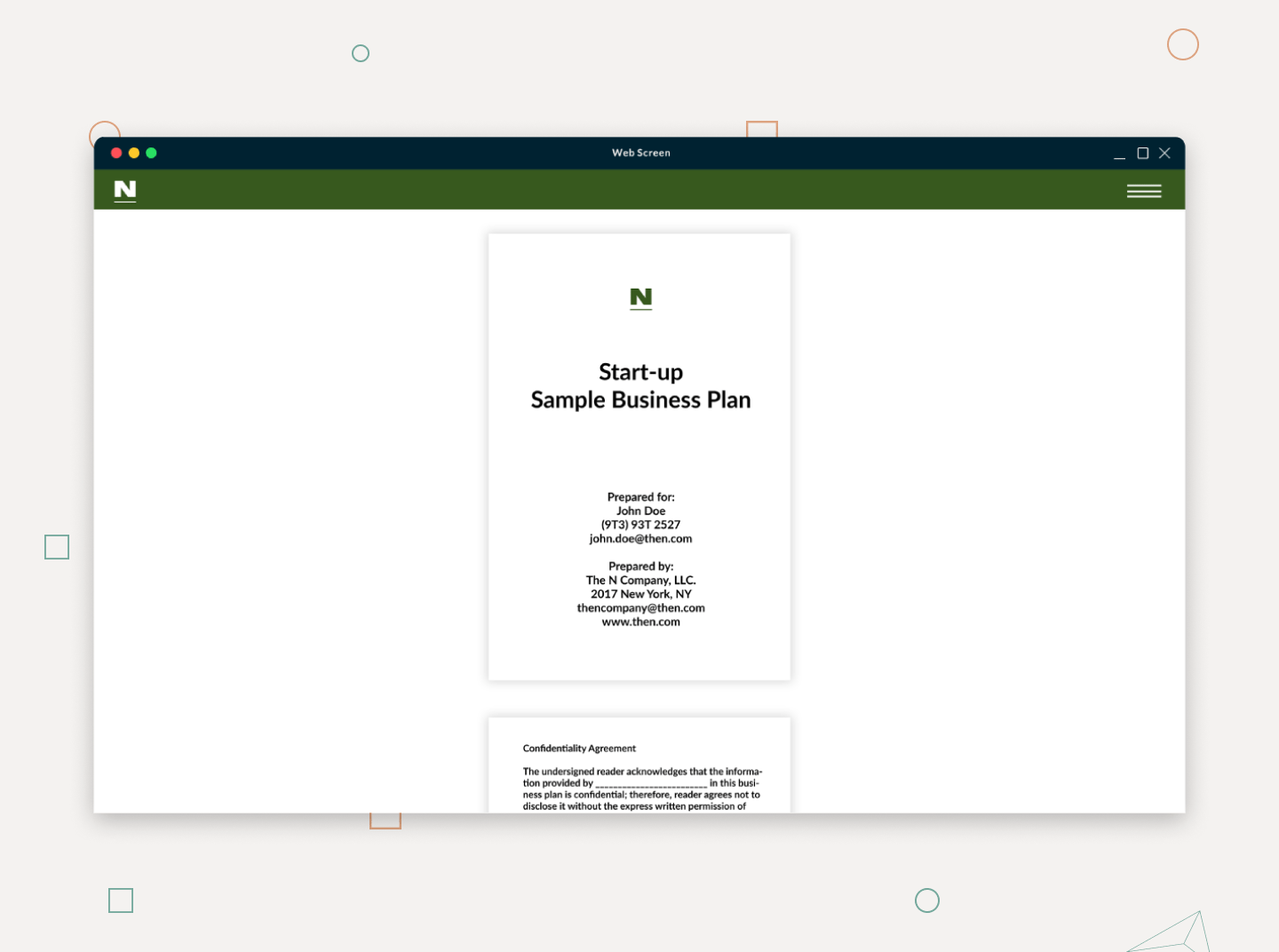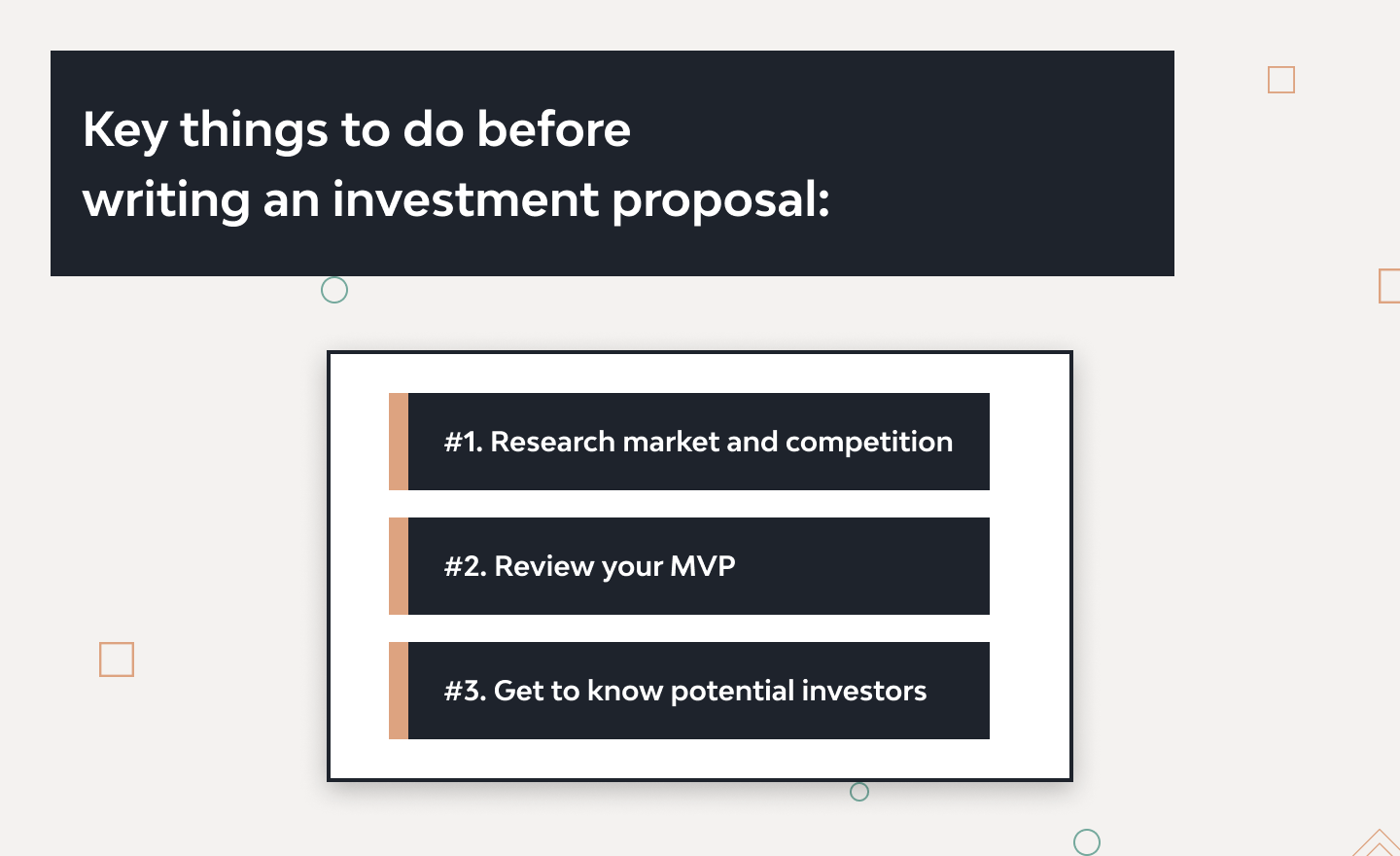Investment Proposal Guide with Examples

Listen to “How to Write an Investment Proposal” on Spreaker.
Roughly one-third of startups fail because of a lack of funding. They may have brilliant ideas, but not enough financial support to survive.
As the financing industry evolves, it has become increasingly selective, emphasizing startups that not only bring visionary concepts but also demonstrate potential for rapid profitability and growth. Recent trends, including a focus on sustainable practices, fintech innovations, and AI integration, have further shaped investor interests. As expectations grow, securing capital requires a strategic approach to communication with potential investors. To bring your great idea to life, you should prepare a compelling presentation that highlights your business’s unique value and financial viability, following best practices on how to write an investment proposal. By detailing market opportunities, competitive advantages, and clear financial projections, an investment proposal can significantly increase the likelihood of obtaining the necessary funding.
However, those new to this topic probably have tons of questions. How to write a business proposal for investors? How long or short should it be? And what should it include?
You’ll find all the necessary information in this guide.
Key Takeaways:
- An Investment Proposal serves as a crucial tool to showcase a startup’s value, its market potential, and its financial viability to potential investors.
- Before getting started, it’s essential to thoroughly research the market and competition, review your product—especially at the MVP stage—and understand the interests and backgrounds of potential investors, as these are all crucial steps in learning how to write an effective investment proposal.
- An effective proposal should include an investment title, executive summary, project details, marketing and sales strategies, operational logistics, and detailed financial projections including an exit strategy.
- Proposals should be clear, concise, and focused on financial details and potential returns to capture investor interest. Avoid unnecessary complexity and irrelevant information that could detract from the main objectives.
- It’s crucial to identify user pain points, develop a working prototype, and establish a clear market entry and scale strategy. This demonstrates preparedness and a solid understanding of the market to potential investors.
But as examples speak louder than a thousand descriptions, here are a few startup investment proposal templates that can be helpful for future reference. The provided links offer editable forms and files for download, allowing you to adapt them according to the details of your own project.
3 Investment Proposal Templates with Examples
Here are some excellent investment proposal samples you can draw inspiration from.
1) The first investment proposal example is the form of a landing page accompanied by descriptions and illustrations of the startup and its competitive advantages. The proposed startup wants to build invoicing software for small businesses.
2) The second startup investment proposal is a presentation that can be shown to an audience or sent as a PDF. This startup investment proposal template provides cues as to where you can insert your own information.
3) The last type of investment proposal template is a traditional text document written as part of a business plan. Click this link to download an editable template.
Now let’s examine what an Investment Proposal is all about.
What Is an Investment Proposal?
In simple terms, an investment proposal is a text document, PDF, or slide show presentation about your startup (product or service) whose purpose is to raise capital. It appeals to people who have money and may be interested in contributing financially.
A successful investment proposal delivers solid arguments as to why your startup is worth investing in, which requires preparation before you start writing. Also, the startup funding proposal should be presented at an appropriate stage of product development — that is, at the MVP stage.
Read more: Request for Proposal (RFP): A Guide to Creating an Effective Document
Business Plan vs. Investment Proposal
While an investment proposal and a business plan may seem similar, as both are crucial documents for a startup seeking funding, they serve distinct purposes and contain different types of information tailored to their specific audiences.
- Purpose: The main purpose of a business plan is to provide a detailed blueprint of a company’s vision for the future, outlining operational, financial, and marketing strategies over a set period, usually three to five years. In contrast, an investment proposal aims to attract investors and secure funding, focusing on the investment opportunity, return on investment, and financial projections.
- Content: A business plan is comprehensive, detailing the company’s mission, market research, competitive analysis, marketing strategy, organizational structure, and financial forecasts. It sets the stage for strategy and operations, including contingencies and risks. An investment proposal, on the other hand, focuses on the business’s potential profitability, highlighting unique selling points, growth potential, existing and projected financial status, and how the investment will accelerate growth.
- Audience: Business plans target a broad range of stakeholders including potential partners and internal executives, guiding both strategic direction and internal management. Investment proposals are tailored specifically for investors — whether angel investors, venture capitalists, or other financial entities — and are crafted to capture their interest by showing financial return opportunities.
- Usage and Timing: A business plan is often developed in the early stages of a business and updated as the business evolves, providing ongoing guidance. Investment proposals are crafted when seeking external funds, particularly after reaching milestones that demonstrate potential for scaling, such as developing a minimum viable product (MVP) or achieving initial market traction.
Understanding the distinctions between these documents is crucial for startup owners, as it influences how they present their business to different audiences and at various stages of development. Both require careful preparation, clear communication, and a deep understanding of the business’s goals and market environment.
What You Should Do Before Writing an Investment Proposal
Before you start writing an investment proposal for startup launching, you need to prepare, and do it in stages:
#1. Research Your Market and Competition
A startup’s success greatly depends on the discovery phase. This is when you gather data from a market analysis and use it to define the product-market fit. The discovery stage helps you eliminate many of the risks related to unexpected expenses, lack of market demand, and other potential issues.
Let’s take a detailed look at the different parts of the discovery phase:
Market Size, Potential, and Competitors
Identifying and scoping your segment of the market, customer and product demand, and competitors is half of the discovery phase. This is a vital part of the process, since it helps you figure out the size and potential of the market, find the gaps in the industry, and define your product-market fit. Along with that, it’s also useful in that it helps you figure out how to withstand the competition – and you might lure clients away from it.
Buyer Personas and Customer Journey
The discovery phase should yield a customer journey map. This map is based on your buyer personas – the marketing avatars of people who would use your product – and basically identify the touchpoints that your users will interact with. It’s a crucial part of the discovery phase, since the first contact a customer has with your product can make or break their experience. So does each contact after that.
A customer journey map will help you anticipate some of the difficulties your buyer persona might encounter, find the best ways to address them, and help ensure a better user experience.
#2. Review Your Product
As mentioned above, the best time to start writing an investment proposal is when you have your MVP — minimum viable product — or an early version of your product that has enough functionality to make it viable for users, but still requires some development effort and time. At this stage, you should also have figured out your business goals and buyer personas.
Presenting your MVP will show a deep understanding of your potential audience and demonstrate that you can satisfy their needs.
#3. Gather Information about Investors
First, you should identify what investors you wish to attract. They can be grouped into a few different categories:
- Angel investors and angel groups. These are high-net-worth individuals and groups that fund startups in return for stock, which makes them just as invested in a startup’s success as they are in getting returns. Most of the time, they also have a wealth of entrepreneurial experience, so they can also mentor or coach you.
- Banks. These are not the most common source of investments for startups, but you can still take your proposal to a bank once your project starts to show progress (e.g., by gaining customers).
- Venture capital firms. These companies usually close more deals than angels, as they have more fuel to power startups. Your choice of VC will usually depend on your location, as most of them are created equal.
- Corporate investors. Some corporations take an interest in funding startups as a way to acquire new assets and identify new technology, all of which can help them grow their revenue.
- Peer-to-peer and personal investors. This group can include your close relatives and acquaintances, P2P lenders, and crowdfunding platforms. Friends and family are usually the first people on the list, and sometimes they can lend you a decent sum. However, you can also go straight to potential customers and launch a crowdfunding project.
Another source of funding is accelerator programs, which help develop your idea and gain traction. These can offer you from $10K to $120K in seed money, as well as additional startup resources such as industry or financial management knowledge.
After you determine the type or types of investors and form a list of target entities, you should do research on:
- Their main field or focus
- If they plan to venture into new territories
- What projects they’ve already funded
- What projects they rejected, and why
- Any additional public information that might be useful (such as interviews, area of interest, etc.).
Also, keep in mind what kind of investor you will be writing for, and consider writing a couple of tailored proposals. For instance, if you seek help from bankers, they will be more invested in the financial side of things, while an angel investor will want to know more about your finances and marketing ideas.
#4. What do Investors Want to See in a Business Plan?
When preparing an investment proposal meaning convincing an investor to commit to your business plan, you can rest assured that any serious investor will definitely look at how competent your team is and how focused your product is on solving actual user problems. Also, it matters for them to consider the size of the market you are targeting and the percentage of it you plan to capture. And of course, they will also review all aspects related to your startup’s financial viability and cash flow.
Perhaps you’ll also find it interesting to look into the more detailed article on creating an investor-attractive product.
Key Components of an Investment Proposal
As mentioned above, an investment proposal can be an ordinary text document or a PDF with graphics. It can also be a presentation created with software such as PowerPoint or Keynote. The format of your proposal largely depends on the type of investor you choose, but it’s always possible to go with all three formats.
However, there are certain must-have elements in every proposal. They are:
Investment Title
Everything starts with a name, and your proposal needs one as well. Ideally, it should be a few words that describe the value of the future product or service and the direction you are taking it, such as the market segment.
Example: Investment Planning Platform
Catchy doesn’t necessarily mean enthralling. A title like our example gets straight to the point — in this case, you want to build an investment platform people can use to plan their future income.
Executive Summary
A business proposal for investors starts with a cover page, followed by a table of contents. The body of the document should begin with an executive summary. In this summary, you should include your value proposition – that is, a short statement that conveys information about your target customer, their problem, your proposed solution, and the benefits your solution offers to the customer and the investor.
You should mention the ROI you expect to yield from the required investment right away. It’s also good to relate success stories, if any, of your experience as an entrepreneur or of your company (in case your startup is branching out from an established business) to further instill confidence in your competence.
Keep it realistic, and keep in mind a key question: What’s in it for the investor? Make your proposal scream out that your idea can actually make money by creating a convincing proposition.
Project Details
This section requires all the facts and arguments supporting you as an entrepreneur, your company (if you already have one), and your MVP – specifically, how you plan to bring it to life.
Company performance
If it’s an existing company, include a business description and provide historical and current financial data. If you haven’t yet established a business, share information about products you’ve been involved in and made a significant contribution to, the stakeholders in the current project and their achievements, and compelling market statistics that underscore your startup’s potential.
Planned marketing and sales methods
In this part of the document, present all the research you’ve done on your market and its competition.
This section should also outline your marketing strategies and channels, and your sales strategy. A key point here might be the pricing model you’ve chosen for your product and a rationale for why it’s the most profitable one.
Operational team logistics
Another piece of information that can help potential investors form a positive opinion of your startup and its potential is the structure of your current team – the one that will achieve your goals. This can include the location of your business, the number of employees you have hired/ plan to hire, the equipment and/or technology you need to get the project up and running, and any applicable operational expenses.
Project financing
Seeing how this is the entire goal of the proposal, make sure you use accurate numbers and include lots of detail. This part should specify the sources of funding, forecasts, timeframes, ROI, and the investment exit plan.
An exit strategy is a crucial point in an investment proposal that’s necessary in two situations:
- When a business has met predetermined investment criteria; or
- When a business has failed to achieve its defined profit objective.
Usually, it’s a contingency plan with information on what to do to limit financial losses if the business goes under.
How to Write an Investment Proposal in 4 Steps
Before we get to the section with startup investment proposal templates, let’s take a look at a few tips. As in many other cases, when writing a business proposal for investors, they are of two types: what to do and what to avoid.
What to Avoid
The investment proposal can be a lifeline for any startup, so it’s crucial to make a compelling argument for your case. At the same time, it has to be straight to the point and factual to highlight your competence in your field. We’ve already discussed what will get you there, so here are some things that you should avoid along the way:
Don’t make it complicated
The text should be understandable to anyone who reads it, not just your peers. Besides, using a lot of jargon or complex phrases might sound like you have copied information instead of describing it in your own words. Simple wording also shows you can be on even footing with your potential customers. How can you attract someone’s attention if they don’t understand what you’re talking about?
Don’t be shy
Don’t beat around the bush when talking about the financial support you require. Be precise about the amount of money you want to raise, what you will do with it, and why you need it.
Avoid irrelevant information
Include only the information that is relevant. Your skills and experience may be impressive, but if they aren’t complementary to the business or the proposal, they’ll simply create information noise.
Don’t be obsessive
Don’t fixate on any information you provide in the startup funding proposal, as this might be viewed as unprofessional.
Don’t make it too long
When deciding how to propose a business plan to investors, keep in mind that their time is often limited. A long proposal may not be read at all. Be considerate of the time someone will need to spend reading and assessing your proposal, as well as of your own time.
What to Do
Simply put, you should strive to make your presentation as compelling as possible and show that you have all the right answers. Therefore, along with other tips on how to write a business proposal for investors, it makes sense that you pay attention to the following points.
Discover the user pain points
When formulating hypotheses about your startup, it’s best to support them with data. Surveys, interviews, focus groups, and other methods can help you with this. The idea of a problem-solving business is exactly what investors want to see in your investment proposal presentation. However, it’s not necessary to solve all the identified problems at once. Instead, you can map out a release plan for more and more advanced versions of your product.
Build a working prototype
A demonstration is more convincing than words. And it’s an excellent way to show investors that you know how to turn their money into a working solution. Don’t have a working version of the product yet? Looking for a tech partner to develop it? We’ll be glad to discuss your idea with you.
Do a trial
Before writing a business proposal for investors, it may be helpful to get honest feedback on your prototype from a small group of early users. Analyzing it will help you better understand what people expect from your product/service and how to improve it to meet these expectations.
Develop your strategy
Also, make sure that your investment proposal presentation includes a clear plan for launching and scaling. Investors need to understand your startup’s potential, which includes market size and a customer value proposition (the reason why customers will buy the product). As a founder, you may not have a formed value proposition at the start, but keeping such questions in mind increases your investment chances.
Conclusion
A project investment proposal is a key document that every startup needs to obtain financial support. An ideal startup funding proposal provides accurate data and predictions that demonstrate to investors your competence and ability to profit, which ultimately will repay their contributions.
If you want to increase your project’s chances of success, don’t jump into creating a proposal. Take the time to gather all necessary information and follow universally accepted guidelines on how to write a business proposal for investors. After all, an investor might not even read it if the title isn’t catchy enough. So, pay special attention to the proposal’s structure, and include only relevant information that creates a positive, but realistic assessment of your startup’s potential. Don’t make abstract statements, and be precise in your calculations.
If you need to develop an MVP or complete a Discovery phase, let the Django Stars team know.
- What should an investment proposal include?
- Must-have elements in every proposal are the following:
- Investment title (a few words that describe the value of the future product or service and the direction you are taking it)
- Executive summary (include your value proposition)
- Project details (company performance, planned marketing and sales methods, operational team logistics, and project financing)
- What to avoid when writing an investment proposal?
- The investment proposal has to be straight to the point and factual to highlight your competence in your field. Here are some things to avoid along the way:
- Don’t make it complicated
- Don’t be shy about your need (be precise about the amount of money you want to raise, why you need it, and what you will do with it)
- Avoid irrelevant information
- Don’t be obsessive
- Don’t make it too long
- How long does it take to write a business proposal for investors?
- The terms for preparing a business proposal depend on the following:
- Your market and competition research,
- Having MVP to review your product,
- Information you have gathered about investors,
- Your understanding of what investors want to see in a business plan.
- Is there a difference between a startup investment proposal and a startup funding proposal?
- An investment proposal is a text document, PDF, or slide show presentation about your startup (product or service) whose purpose is to raise capital. It appeals to people who have money and may be interested in contributing financially. A funding proposal is also a request for financial support, but the projects for which it is prepared are usually humanitarian or community-minded.
- How to present a business plan to investors?
- To present a business plan to investors effectively, start by clearly outlining your business idea, market opportunity, and unique value proposition. Focus on key sections such as your business model, target market, competitive advantage, marketing strategy, financial projections, and funding requirements. Use a well-structured pitch deck with concise visuals and data to support your points. Practice delivering your presentation confidently and be prepared to answer questions about your assumptions, financials, and growth strategy. Tailor your approach to your audience by understanding their interests and investment criteria.













